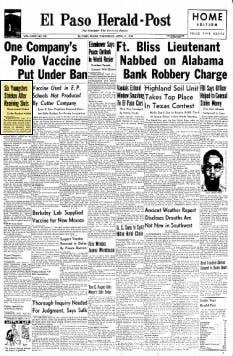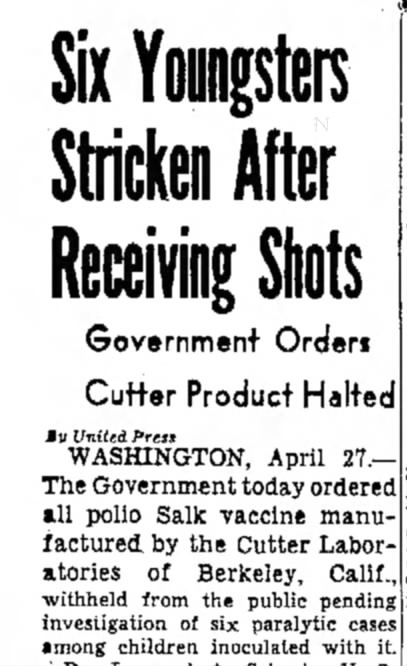The deadliest mass vaccination tragedy no one has heard of
Dr. Paul A. Offit called it "one of the worst biological disasters in American history"
The day was Aug. 30, 1954. Bernice Eddy, Ph.D, an American virologist, epidemiologist and a veteran scientist at the National Institutes of Health in Bethesda, Maryland, was hard at work assiduously checking batches of the recently synthesized polio vaccine for safety.
As she checked a sample from Cutter Laboratories in Berkeley, Calif., she noticed that the vaccine—designed to protect against polio— had instead caused polio in a test monkey. She was shocked to discover that rather than containing killed virus to induce an immune response, the sample from Cutter Lab contained live, infectious polio virus. Three of the six samples had paralyzed test monkeys.
Something was wrong. “There’s going to be a disaster,” she told a friend.
Jonas Edward Salk was an American virologist and medical researcher. At that time, the established paradigm of vaccine development was to first isolate a ‘live’ but weakened micro-organism. This attenuated virus or bacteria would then be administered to patients in order to create a low-grade, innocuous infection that would confer long-standing immunity. Salk challenged this approach. Replicating his prior work on the influenza vaccine, Salk and his team used formaldehyde to kill the poliovirus without destroying its antigenic properties.
The scourge of polio had created a media frenzy and a nation desperate for a cure. This put public health agencies under the microscope and led to a race to create a vaccine. Jonas Salk fancied himself the front runner being funded by no less than US President Franklin D Roosevelt himself through the National Foundation for Infantile Paralysis (now widely known as the March of Dimes). Salk hailed his killed virus polio vaccine as the miracle drug that would conquer the dreaded illness that killed and paralyzed children. So confident was Salk in the safety and efficacy of his vaccine that he tested it on himself, his wife and three children in 1953.
Subsequently, a study conducted using Salk’s vaccine found that children who did not get the vaccine were three times more likely to be paralyzed with polio than those who received the vaccine.
The news made front-page headlines across the country. People wept and parades were held in Jonas Salk’s honor. That same day, licenses were hurriedly granted to several drug companies, including Cutter Laboratories, to make the vaccine. It was under these circumstances in 1954 that Bernice Eddy was asked to help test the Salk polio vaccine prior to making it available to the general public. The pressure was intense. For weeks she and her staff worked around-the-clock, seven days a week.
Eddy’s job that fateful morning was to examine samples submitted by the companies making Salk’s killed virus polio vaccine. As soon as the impending catastrophe dawned on Eddy, she brought it to the attention of her supervisor, Dr. William Workman. Dr. Workman never told the licensing committee, and the Cutter vaccine was approved and shipped out. The official explanation blamed “scientific and bureaucratic chaos” and intense public pressure in the rush to make the vaccine available to the public after Salk had announced a “safe and effective” vaccine against polio. Remember, Salk was by then a national hero and portrayed by the media as the man who conquered polio. It’s not a stretch of imagination to suppose none of Eddy’s higher ups wanted to commit career suicide by being the ones pulling the plug on a vaccine greeted as a miracle cure.
Eddy’s warnings went unheeded and an estimated 120,000 children that year were injected with the Cutter vaccine, according to Paul A. Offit, director of the Vaccine Education Center at Children’s Hospital of Philadelphia and member of the FDA’s advisory committee on vaccines.
Roughly 40,000 got “abortive” polio, with fever, sore throat, headache, vomiting and muscle pain. Fifty-one were paralyzed, and five died, Offit wrote in his 2005 book, “The Cutter Incident: How America’s First Polio Vaccine Led to the Growing Vaccine Crisis.”
It was “one of the worst biological disasters in American history: a man-made polio epidemic,” Offit wrote.
Starting the evening of April 12, 1955, batches of the Salk vaccine made by five drug firms were shipped out in boxes marked “POLIO VACCINE: RUSH.”
About 165,000 doses of Cutter’s went out.
Within weeks, reports of mysterious polio-like infections started coming in.
On April 27, 7-year-old Susan Pierce, of Pocatello, Idaho, died of polio days after getting the Cutter vaccine. She had been placed in an iron lung just before she died. Her brother Kenneth had been vaccinated at the same time, but he was okay.
Other cases followed.
Alton Ochsner, a professor of surgery at Tulane Medical School and founder of the Ochsner Clinic in New Orleans, gave the vaccine to his grandson Eugene Davis, Offit wrote. The child died May 4.
Not only did some people injected with the tainted vaccine get sick, but some of the vaccinated went on to infect family members and neighbors. This led to an epidemic of polio in the families and communities of the vaccinated children, resulting in a further 113 people paralyzed and 5 deaths. The vaccine was maiming and killing not only the vaccinated but even to those who never received the vaccine. Recall that instead of a killed virus, the vaccine contained live contagious virus that was now spreading between people.
On June 5, 1955, 33-year-old Annabelle Nelson of Montpelier, Idaho, died of polio after her two children had been given the vaccine in April, according to news reports at the time.
The government ordered the Cutter vaccine withdrawn on April 27. But damage had been done.
“By April 30, within forty-eight hours of the recall,” Offit wrote. “Cutter’s vaccine had paralyzed or killed twenty-five children: fourteen in California, seven in Idaho, two in Washington, one in Illinois, and one in Colorado.”
On May 6, all polio vaccinations were postponed. They were resumed on May 15 after the government had rechecked the vaccines for safety.
The end tally was that 260 people contracted polio directly or indirectly from Cutter’s vaccine; 11 died.
Years later, in a suit brought against Cutter, the firm was found not negligent in making its vaccine because it had done its best making a new drug that was complicated to produce.
But it was found financially liable for the calamity it had caused during that spring of 1955.
The jury foreman said: “Cutter Laboratories [brought] to market a … vaccine which when given to plaintiffs caused them to come down with polio.”
In the aftermath of the Cutter incident, Eddy was relieved of her polio control testing duties in 1955 but continued to work in biologics. While she had been at the center of the polio controversy, she had the courage to stand by her convictions and research against significant opposition. Workman was also forced out of his job as head of the Laboratory of Biologics Control, but stayed on as Chief of the Laboratory of Control Activities until he retired in 1963.
Eddy later recounted, “This was a product that had never been made before, and they were going to use it right away”
“What do you think is wrong with these monkeys?” she asked a colleague.
“They were given polio,” the colleague replied.
“No,” Eddy said. “They were given the … vaccine.”
In response to this national tragedy, the National Institutes of Health and Public Health Services developed minimal safety and potency standards for all polio vaccine in the United States and a Technical Committee on Poliomyelitis Vaccine was established in May 1955. This permanent committee tested and reviewed all polio vaccine lots and advised the Public Health Service as to which lots should be released for public use.
Dr. Paul A. Offit attributes the modern-day “growing vaccine crisis” to the Cutter incident, which is interesting, since I don’t know of too many people who are aware of this aspect of our medical history. In fact conducting a google search of the polio vaccine rarely, if ever, brings up any mention that this even occurred.
The other peculiarity of this saga is that it was christened the Cutter “incident,” as if to downplay the immensity of the tragedy that transpired. A fender bender is an incident. Hundreds of paralyzed children is a tragedy any way you look at it. Further digging reveals that although all initial cases had received vaccine manufactured by one company—Cutter Laboratories— the vaccine made by Wyeth also caused several cases of polio. Again, finding any mention of this fact requires one go down the rabbit hole of history. Was this another attempt to minimize widespread systemic regulatory failure?
The introduction of the Salk polio vaccine represents one of the most important advances in modern public health. Salk’s inactivated poliovirus vaccine progressed from bench-to-bedside to the community within 6 years. Much of the driving force behind the rapid implementation was social—the widespread fear of paralytic polio combined with hope that this disease that so devastated children could be eradicated. The serious consequences that arose were a result of its rapid translation and a bureaucracy that prioritized the narrative over people. This is a lesson that deserves to never be forgotten , especially by the stewards of public health. A little bit of humility, a whole lot of conscientiousness and putting people over career goes a long way. The only way to break the cycle of history repeating itself is to find our inner Bernice Eddy, speak without fear of retribution and as if someone’s life depended on it.
Thank you for reading. I hope you found this as illuminating as I did researching and writing about it. There’s another spellbinding twist to this story that I will get to in a future post. To receive new posts and support my work, please consider becoming a free or paid subscriber. While you’re here, feel free to read my other essays and share them with your friends. As always, I enjoy reading your comments and try to respond to them as much as I can. Your patronage is very much appreciated.











It’s almost as if not only Occam’s Razor and heuristics suggest there is some truth to conspiracy theories around contagion, virology, vaccines and infectious disease all being mostly settled pseudo-science twaddle to prop up lucrative medical industrial complex scams and grifts... there may also be hard evidence for institutional corruption, wilful iatrogenesis and malfeasance with grounds for criminal prosecution. Happy days.
I've read that polio was a late-19th, mid-20th century phenomenon in the USA that was caused by pesticides. It didn't exist before.
That background puts the "success" of public health in a different light.